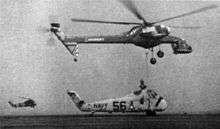Sikorsky S-60
The Sikorsky S-60 helicopter, a prototype "flying crane", was derived from the S-56 in 1958. Proving to be underpowered, the development of the S-60 led to the larger, turbine-engined Sikorsky CH-54 Tarhe military transport helicopter, and its civil S-64 Skycrane variant, which were already on the drawing board by the time the sole example of the S-60 crashed on 3 April 1961.[1]
| S-60 | |
|---|---|
 | |
| The Sikorsky S-60 | |
| Role | Cargo helicopter |
| Manufacturer | Sikorsky Aircraft |
| First flight | 25 March 1959 |
| Status | Crashed in April 1961 |
| Number built | 1 |
| Developed from | Sikorsky CH-37 Mojave |
| Developed into | Sikorsky S-64 Skycrane |
Design and development

In 1958, Sikorsky began designing the S-60 as a prototype "flying crane" helicopter. The S-60 utilized the transmission, rotor system and piston engines from the CH-37/S-56.[2][3]
The fuselage of the S-60 was a simple "pod-and-boom" design with the engines mounted in side pods and long tailwheel-style landing gear that allowed it to straddle cargoes. The crew cabin was mounted in the nose, with aft-mounted controls for the co-pilot to use during loading and unloading operations. The S-60 had an automatic stabilization system to allow it to hover precisely, using inputs from a sidestick controller. Up to 12,000 pounds (5,400 kg) of outsized cargo such as vehicles could be slung beneath the boom, while passengers and other cargo could be carried in a large interchangeable pod that attached to the fuselage.[2][3]
Operational history

The S-60 (registered N807) first flew on March 25, 1959. The helicopter accumulated 333 hours of flight in its two-year flight career, and was evaluated by the US Navy, with demonstrations also flown for the US Army. While effective in its designed role, the helicopter proved to be underpowered. Sikorsky was already working on an enlarged, turboshaft-powered successor, the Model S-64, which was ordered into production for the US Army as the Sikorsky CH-54 Tarhe.[2][3]
Igor Sikorsky was fully involved in the development of the prototype S-60, from the initial design through flight testing. It was one of the last aircraft to have this distinction. The prototype crashed in April 1961.[4]
Survivor
The wreckage of the S-60 was transferred to the New England Air Museum in the 1970s, and is currently being restored by its new owners, the Connecticut Air and Space Center, in Stratford, Connecticut.[5]
Specifications (S-60)
Data from The Complete Encyclopedia of World Aircraft[2]
General characteristics
- Crew: three
- Capacity: 12,000 lb
- Length: 87 ft 11 in (26.8 m)
- Rotor diameter: 72 ft 1 in (22.0 m)
- Height: 17 ft in (m)
- Disc area: 4,080 ft2 (379 m2)
- Empty weight: lb (kg)
- Max. takeoff weight: 21,000 lb (9,500 kg)
- Powerplant: 2 × Pratt & Whitney R-2800-54 "Double Wasp" radial engines, 2,100 hp (1,600 kW) each
Performance
- Maximum speed: 131 mph (114 knots, 211 km/h)
- Range: 247 mi (215 nm, 400 km)
- Service ceiling: 8,000 ft (m)
See also
Related development
Aircraft of comparable role, configuration and era
Related lists
References
- Notes
- "Occurrence #70643: Sikorsky S-60 crash: 3 April 1961." Aviation Safety Network. Retrieved: 14 June 2011.
- Donald 1997, p.?
- Harding 1997, p. 237.
- Warbird Information Exchange
- "S-60 Prototype SkyCrane." cascstratford.wordpress.com. Retrieved: 23 November 2010.
- Bibliography
- Donald, David, ed. The Complete Encyclopedia of World Aircraft. New York: Barnes & Noble, 1997. ISBN 0-7607-0592-5.
- Harding, Stephen. U.S. Army Aircraft Since 1947: An Illustrated History. Atglen, Pennsylvania: Schiffer Publishing Ltd., 1997, First edition 1990. ISBN 978-0-7643-0190-2.
External links
| Wikimedia Commons has media related to Sikorsky S-60. |